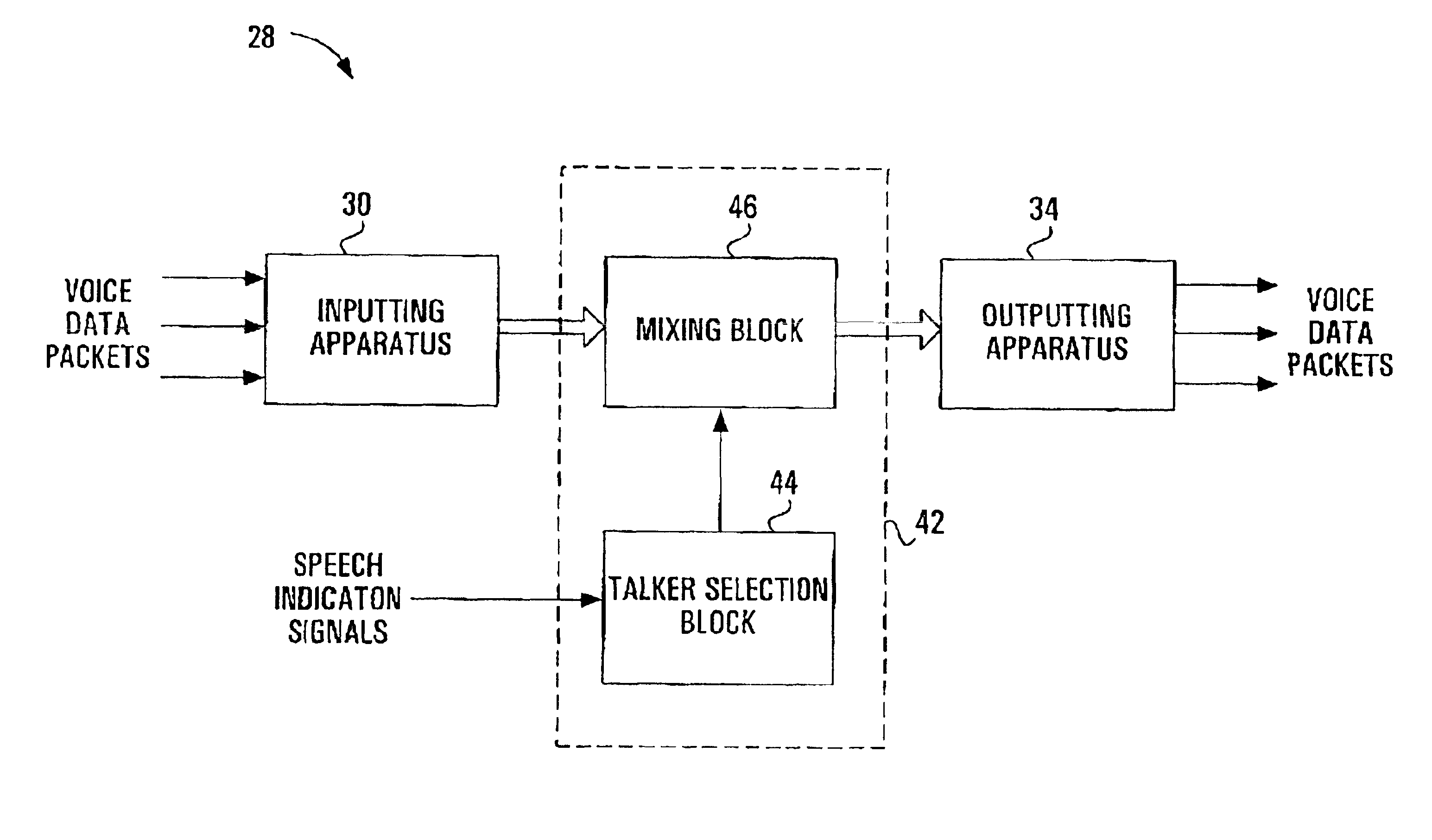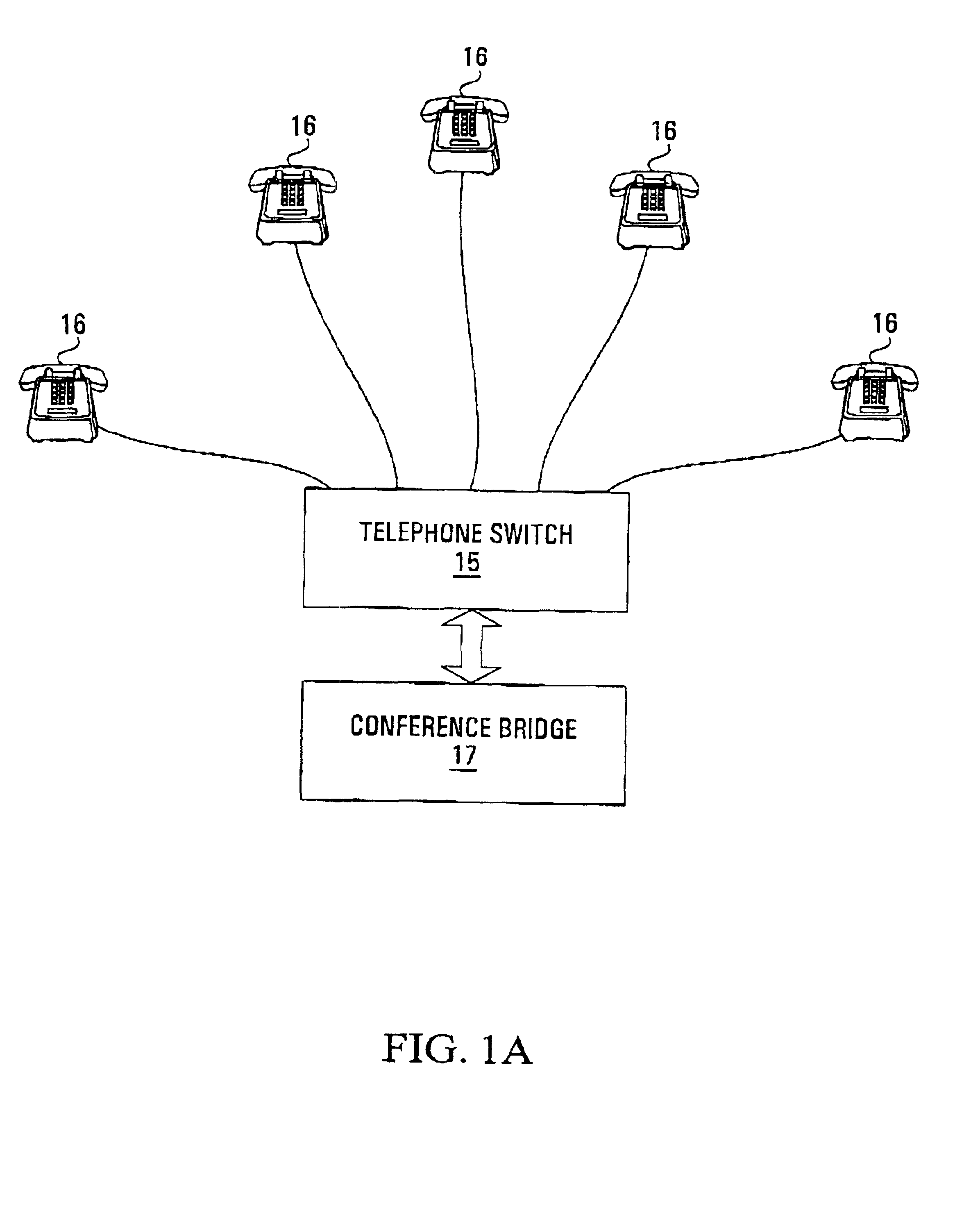Apparatus and method for packet-based media communications
a packet-based media and media communication technology, applied in the field of packet-based media communications, can solve the problems of large amount of signal processing power, noise that is combined during the mixing step, and inherently created latency within, so as to reduce the amount of processing power, reduce the latency of voice data packets, and reduce transcoding
- Summary
- Abstract
- Description
- Claims
- Application Information
AI Technical Summary
Benefits of technology
Problems solved by technology
Method used
Image
Examples
first embodiment
[0043]the present invention, in which reduced processing is required within the packet-based conference bridge compared to well-known conference bridge designs, is now described with reference to FIGS. 4, 5, 6A and 6B. In this embodiment, speech indication signals are sent from the packet-based terminals 22,24,26 within the voice conference to the packet-based conference bridge 28 so that no speech detection operation needs to be performed within the conference bridge itself. in one implementation, these speech indication signals simply indicate if a participant corresponding to a particular packet-based terminal is speaking or not. In other implementations, the speech indication signals indicates other parameters that could be utilized by a talker selection algorithm to select a set of the packet-based terminals as talkers. For example, in one implementation, the parameters within the speech indication signals correspond to the energy level of the speech associated with the partici...
second embodiment
[0070]FIG. 7 is a logical block diagram illustrating a packet-based conference bridge according to the present invention. This packet-based conference bridge replaces within FIG. 1B, the well-known packet-based conference bridge depicted within FIG. 2. As depicted in FIG. 7, the packet-based conference bridge 28 comprises the inputting apparatus 30 similar to that described above with reference to FIG. 2. The difference in the packet-based conference bridge 28 of FIG. 7 is the removal of the energy detection, talker selection and mixing block 32 and the outputting apparatus 34 and the insertion of energy detection and talker selection block 100 coupled to the inputting apparatus 30.
[0071]In operation, the energy detection and talker selection block 100 receives the voice signals corresponding to participants within a voice conference from the inputting apparatus 30, performs an energy detection operation on the received voice signals to determine which packet-based terminals within ...
third embodiment
[0089]In this third embodiment of the present invention, the packet-based conference bridge 28 is reduced to simply a talker selection block 150 as illustrated in FIG. 11. The talker selection block 150 operates in similar fashion to talker selection block 44 in terms of selecting talkers based upon the received speech indication signals while the block 150 operates in similar fashion to block 100 in terms of sending addressing control signals based upon the selection of the talker(s). The talker selection block 150 could be implemented in numerous manners similar to the blocks 44,100 described above with reference to FIGS. 4 and 7 respectively.
[0090]FIG. 12 is a logical block diagram illustrating a packet-based terminal according to the third embodiment of the present invention. As depicted within FIG. 12, the packet-based terminal comprises similar components to the packet-based terminal described above with reference to FIG. 8 but additionally comprising the speech detector 66 pr...
PUM
 Login to View More
Login to View More Abstract
Description
Claims
Application Information
 Login to View More
Login to View More - R&D
- Intellectual Property
- Life Sciences
- Materials
- Tech Scout
- Unparalleled Data Quality
- Higher Quality Content
- 60% Fewer Hallucinations
Browse by: Latest US Patents, China's latest patents, Technical Efficacy Thesaurus, Application Domain, Technology Topic, Popular Technical Reports.
© 2025 PatSnap. All rights reserved.Legal|Privacy policy|Modern Slavery Act Transparency Statement|Sitemap|About US| Contact US: help@patsnap.com



